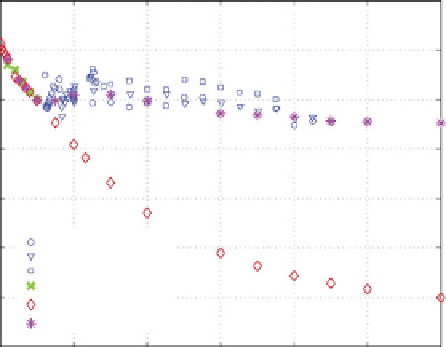Geoscience Reference
In-Depth Information
that this scaling applies more precisely to the Péclet num-
ber Pe (=
1.4.1. Eddy Heat Transfer in Oceans and Atmospheres
1; see equation (1.24)), which decays more
rapidly with
toward zero than
N
−
Note that the above arguments will apply in a qualitative
sensetoaplanetaryatmospheresavethatthestatetowhich
the thermal structure relaxes in the absence of (large-
scale) fluid motion is one not of conductive equilibrium
but of radiative (or radiative-convective) equilibrium [e.g.,
Pierrehumbert
, 2010]. This would suggest that parameters
measuring the efficiency of atmospheric heat transport,
such as the Nusselt number
N
(which decays toward
N
= 1). Since conductive heat transport is always present
and is unaffected by rotation, the resultant thermal field
becomes increasingly dominated by conduction. Hence,
the isotherm structure will tend toward the vertical align-
ment characteristic of the conductive state as
increases.
It is reasonable, therefore, for waves to develop in such a
flow provided they are able to transfer heat radially in the
interior, which is possible in a geostrophically balanced
rotating fluid since waves are associated witha periodically
varying azimuthal pressure gradient to balance a radial
geostrophic flow.
Laboratory experiments show that such wavelike distur-
bances with these properties will frequently develop under
many circumstances, with the primary role of transferring
heat and releasing “available”potential energy. When such
waves are present, experiments have consistently demon-
strated that they increase the effectiveness of advective
heat transfer quite significantly. The experimental mea-
surements and simulations represented in Figure 1.18
show this effect very clearly, more or less maintaining
the total Nusselt number of the whole system at a value
close to its nonrotating value. Such an effect has been
noted since the early work of
Bowden
[1961] and
Bowden
and Eden
[1965], though a fully quantitative, theoretical
understanding of this has remained elusive.
N
, need to be redefined, for
example, with respect to a radiative-convective equilib-
rium state rather than a pure conductive one. In the case of
Earth, pure radiative-convective equilibrium would result
in a temperature contrast between equator and poles of
∼
60 K observed on average [e.g.,
Andrews et al.
, 1987], indicating the dominant role of
dynamical advective heat transport in the atmosphere.
Similar considerations may apply in the oceans, for which
parameterization of baroclinic eddy transports are of par-
ticular importance. This is because the scales of baroclinic
instability are so much smaller than the domain scale of an
ocean basin that they are extremely difficult and/or expen-
sive to resolve adequately in ocean circulation numeri-
cal models.
Various approaches toward the parameterization of
eddy transports have been developed over many years
for this purpose [e.g.,
Plumb and Mahlman
, 1987;
Gent
and McWilliams
, 1990;
Gent et al.
, 1995;
Treguier et al.
,
1997;
Killworth
, 1997;
Visbeck et al.
, 1997;
Marshall and
Adcroft
, 2010]. A major advance in the development of
such parameterizations that forms the basis of many con-
temporary schemes in current use in ocean models derives
from the work of
Gent and McWilliams
[1990] and
Gent
et al.
[1995]. Here an “eddy-induced” or “bolus” velocity
is introduced that advects temperature and other tracers in
such a manner as to flatten density surfaces. The original
scheme proposed by
Gent and McWilliams
[1990] derived
such an eddy-induced velocity from a parameterization
of buoyancy fluxes that were assumed to act diffusively
down- gradient with respect to the ambient (e.g., zonal
mean) buoyancy field in the form (suitable for a zonally
reentrant domain):
150 K, instead of
∼
Boundary layer ratio
0
1.61
3.22
4.82
6.43
8.04
14
12
10
8
6
m
= 2 experimental
m
4
= 3 experimental
m
= 4 experimental
u
ρ
∂ρ/∂z
Axisym experimental
2
Axisym numerical (2D)
∂
∂z
u
∗
=
−
(1.25)
3D model
0
0
1
2
3
4
5
6
∂χ
GM
∂z
−
,
(1.26)
=
Ω
(rad/s)
u
ρ
∂ρ/∂z
∂
∂y
Figure 1.18.
Experimental and numerically simulated total
heat transport (Nusselt number) in a rotating annulus experi-
ment using data from
Read
[2003] and
Pérez
[2006]. Both 2D
and 3D models were used for the numerical simulations. (See
key inside the figure for a description of each measurement.)
w
∗
=
(1.27)
=
∂χ
GM
∂y
.
(1.28)























